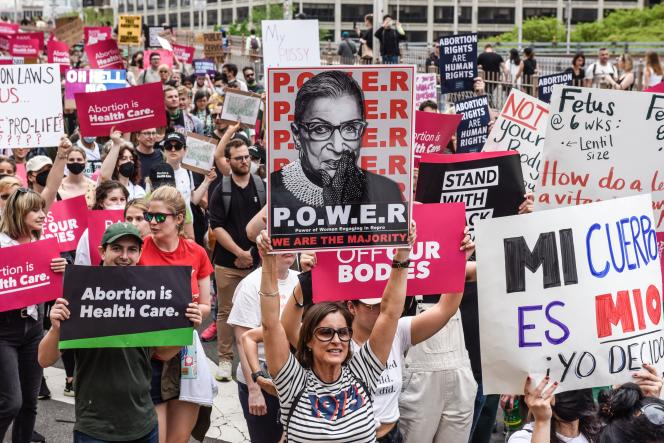How the U.S. is outlawing abortion
- Gabriel Gramicelli

- Nov 25, 2022
- 4 min read
Updated: Nov 28, 2022
Abortion is a sensitive topic due to its ethical implications. Over the years, the US government’s stance on abortion has changed and so did its laws to address the issue. First in 1973 a landmark U.S. supreme court case legalized abortion nationwide. Later in 1992, another case by the court made abortion laws more strict. 30 years later in 2022, the decision to yet another case again changed the abortion landscape in the U.S., and this time, it has received more protest than ever.

Roe v. Wade and Constitutional abortion
The first supreme court case that discussed abortion is the famous Roe v. Wade. Norma McCorvey became pregnant with her third child in 1969 and wanted an abortion. McCorvey lived in Texas, where abortion was strictly illegal in most cases. McCorvey found Sarah Weddington and Linda Coffee, two lawyers that wished to represent her and several other abortion cases in multiple states. Under the pseudonym "Jane Roe", McCorvey kept her anonymity and followed the lawyers’ intentions to argue that Texas's abortion laws (and all other states that prohibit it) were unconstitutional. They fought against Roe’s local district attorney, Henry Wade, therefore naming the case “Roe v. Wade”.
The term ‘unconstitutional’ is a judicial way of claiming that a piece of law (usually applied by a state) goes against the national constitution (something governments clearly don’t want to happen). The argument follows that the due process clause of the Fourteenth Amendment to the United States Constitution: “(...) nor shall any State deprive any person of life, liberty, or property, without due process of law”(U.S. Const. amend. XIV) provides a fundamental "right to privacy", which protects a pregnant woman's right to an abortion.
Contrary to popular opinion at the time, the 1973 court voted in favour of Roe in a 7–2 decision that constitutionalised abortion, meaning that all states had to provide abortions to pregnant women.
When is abortion legal (Planned Parenthood v. Casey)?
In the years to come after Roe v. Wade, states had conflicting views of what circumstances were required for abortion rights. Some states required informed consent, spousal notice, and even parental consent for the right to an abortion, while others didn’t even require identification provided by the female.
This arose the interest of Planned Parenthood, an organization that represents abortion clinics. They sued Pennsylvania governor Bob Casey who had passed some strict abortion requirements, giving the case the name Planned Parenthood v. Casey.
On June 29, 1992, the court sided with Planned Parenthood on a 5-for-4-against vote. Creating some requirements that states must provide for abortion. The main requirement was that all states provide abortion to consenting females until the baby reaches “fetal viability”. Fetal viability is the point during pregnancy when the fetus becomes old enough to survive outside of the womb and is considered by modern doctors to be reached after about 22 weeks of pregnancy. This case further solidified the right to abortion and helped millions of women nationwide that previously weren’t eligible. Though, due to the growing republican representation in the court in the past few years, more pro-life Americans wished for a new abortion case to overturn the previous two.
Dobbs v. Jackson Women's Health Organization
Overturning is when a previous court case’s legal decisions are reverted (such as those of the Roe and Casey cases), and usually, new rules are created. The 50 years of constitutional abortion came to an end on June 24th, 2022. Part of the reason for this is because the supreme court's ideology and members changed rapidly towards conservative beliefs during Trump's administration.
This case arose from an abortion clinic in Mississippi that sued the state for a 2018 law that banned most abortion operations after the first 15 weeks of pregnancy, arguing that it went against the law determined in the Planned Parenthood case.
This time, the supreme court sided with Jackson, arguing that abortion is “not a constitutional right as the Constitution does not mention it and its substantive right was not "deeply rooted" in the country's history, and that individual states have the authority to regulate access to abortion”. They essentially argue that the constitution wasn’t written with the consideration of abortion, and therefore states can decide. This change has therefore allowed Republican-led states to outlaw abortion.
Midterms
Currently, 17 states have banned or are in the process of banning abortion, 11 are considering the option but still allowing it, and all other 22 states plan on keeping it legal. Ever since the court’s decision, protests arose all over the country, and it is estimated that about 60% of the population is against this decision.
Processes to bring back constitutional abortion rights are in development by multiple clinics and pregnant citizens, and there is a possibility that the decision will be reverted. But for the time being, thousands of women with enough income are travelling to other states to get abortions.
In the political world, this decision was largely supported by the conservative Republican judges of the court, impacting the midterm elections that happened on the 8th of November. More voters than expected sided with the Democratic party as they wanted to get back the rights of women to have an abortion. With the house of representatives having a republican majority, and a Democratic majority in the Senate, Congress is split, making it harder for Biden to revert the impacts of the Trump administration.
Citation






Comments